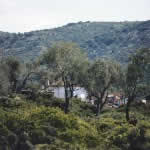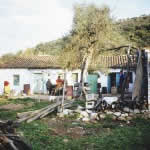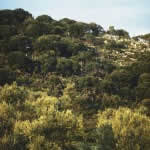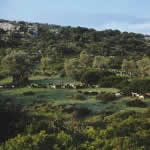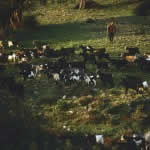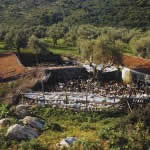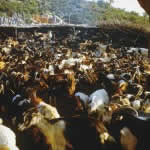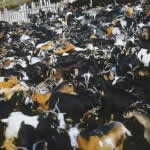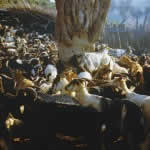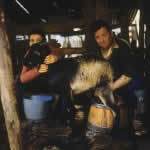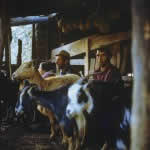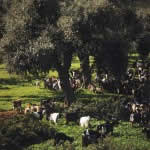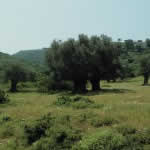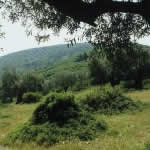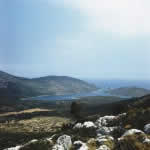On Kyra Panagia Island the traditional pastoral system as illustrated by my photographs of 1976 (and the 16 mm footage shot at the same time) has been abandoned since the conservation area Northern Sporades was established. The goats are not herded and milked anymore.
Already earlier cattle grazing was discontinued (cf. my article: Endemic cattle of the Northern Sporades archipelago).
Athanasios the Athonite had aquired Kyra Panagia for producing there cheese for the monks in the Megisti Lavra, because on Athos no female animals were allowed.
The oak woodland on Kyra Panagia was selectively cut in intervals of several years for burning charcoal. The re-growing oak provided rich pasture for the endemic breed of goats – which had adapted over centuries to the local ecological conditions. The herdsmen worked under contract by the Megisti Lavra. They observed a shifting system of pasture, so the oak woodlands were able to recover. No such ecological practizes have survived.
A more recent study proposes the establishment of 4 zones each utilized by browsing for 3 months.
In recent years the grazing rights were auctioned by the Megisti Lavra in disregard of the park regulations. The park law permits 300 goats for an annual season of 4 months only. But the leaseholders in 2007 collected subsidies for 1.624 goats. (And undisclosed sums of subsidies for other years of leasehold). The number of unregistered goats on the island was much higher still. Regardless of ecological considerations, goats of various non-adapted breeds were introduced from the mailand (see bottom right photograph).
In fact the official Management Body for the marine park in 2008 intended to grant an unlawful grazing license (for all the year round) for 2.400 goats to the monk who had been given authority and instructions by the Megisti Lavra. But the Ministry objected, at last. What an appaling scenario – in view of the original intentions by the Holy Athanasios the Athonite!
On New Year’s Day 2007 I sent a letter of protest to the chairman of the management body for the marine park Northern Sporades; it was never responded to:
“ … Pure vandalism has scared the island of Kyra Panagia – which had retained its original integrity since it was acquired one thousand years ago by the Holy Athanasios the Athonite, for the I.M. Megisti Lavra on Agion Oros.
A bulldozer road has been carved into the coastal zone of the bay Agios Petros upon instructions by monks of the Iera Moni, after years of sucessful prevention of this illegal undertaking by the Ecological Movement of Alonnisos. The road of destruction begins on the scenic spot of the Red Rocks at the shore (a shelter for the monk seal) and extends to the „Kampos“ further inland.
This road is intended to be used in an illegal goat grazing business on the island. According to the park regulations only 300 goats are permitted on Kyra Panagia, and only for a period of 4 months per year. In reality an estimated more than fourthousand goats progressively deplete on the island the formerly rich oak woodlands by their browsing habits, all the year round.
It’s hard to believe, but true: for several years the owners (the Iera Moni) or the lease holders for the grazing rights on Kyra Panagia, respectively, collect huge amounts of money in terms of EC – subsidies for this exploitive venture – while the Greek government and the appointed guardians for the park kept a blind eye on this incredible scandal. Had the responsible authorities acted in time and enforced the park regulations, there should have been no incentive left for the developers to go ahead with their road construction! What an immense tragedy unfolded in this first and greatly applauded marine park in the Mediterranean region …
We urge with all possible emphasis that all these matters and in particular the most recent event of unprecedented tragic destruction and violation of the park regulations has to be brought to the supreme court and all feasible efforts have to be undertaken to remove the scars left by the bulldozer and to restore in detail all the features of the landscape as much as that is possible.
It was a local fisherman who had discovered and reported the road-building act of vandalism – just another proof that the Cooperative of Fishermen of Alonnisos provides the only efficient guarding in the park.
In August 2007 it will be the 50th anniversary of my first visit and exploration of the island of Kyra Panagia. Ever since those days of no threats and no fears, of still practized traditional pasture and monastic life, the close personal acquaintance grew – so it hurts deeply what has happened recently.
In 1976 I proposed the Marine Park including Kyra Panagia for the first time.
In 1977 I wrote in a TV film narration: „never there will be a road on this virgin island, never any development other than conservation“…
I was wrong because I could not foresee the present – day apparent greed, ignorance and disrespect of men who still devote, like in the old days, their monastic lifes to the Virgin Mary – to Kyra Panagia.
And I was equally wrong in my assessment of the Greek government being serious and taking up the responsibility for actually safeguarding the natural and cultural monuments in the Marine Park Alonnisos Northern Sporades.
But I am certainly right in my more advanced, independent assessment: the one to blame for this shambles in the first place is the subvention policy of the European Union; without these incentives for easy fraud and exploitation of irreplaceable natural resources there could have been no such devastation as we had to witness now again on the Holy Island of Kyra Panagia.
Kazaviti on Thassos Island,
1st of January, 2007
Dr. Thomas Schultze-Westrum
